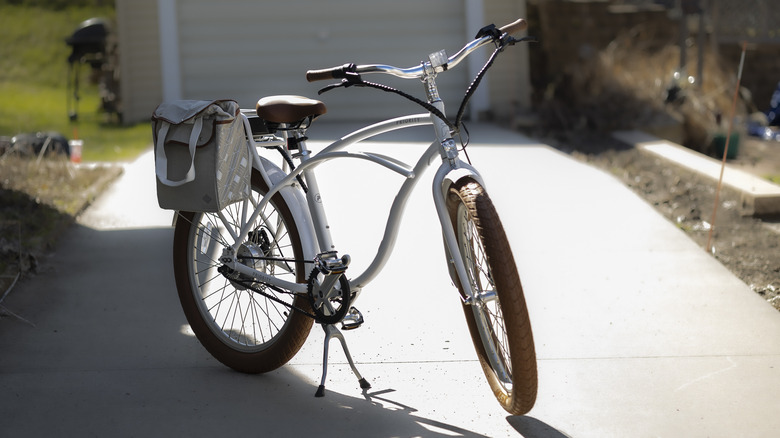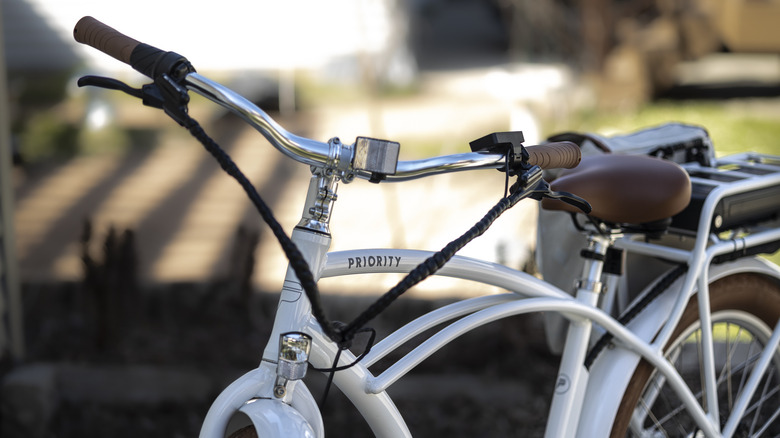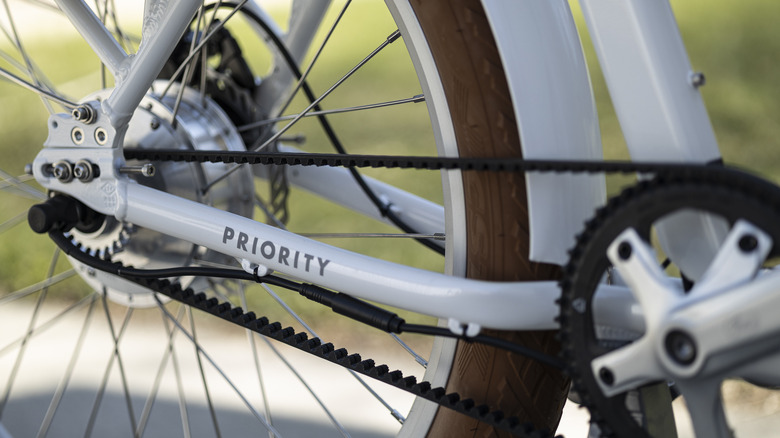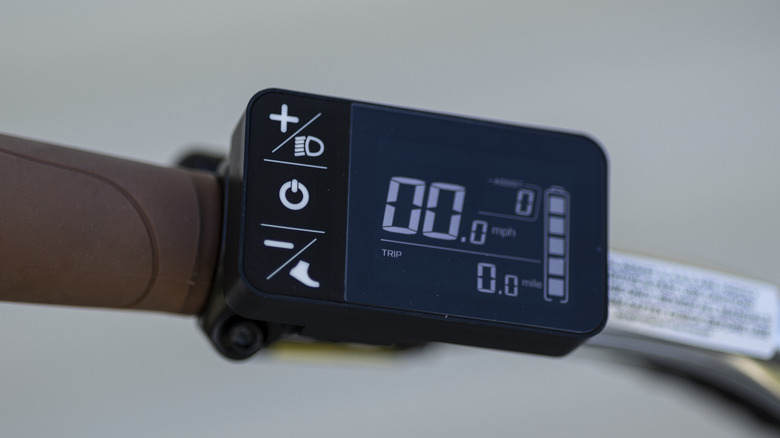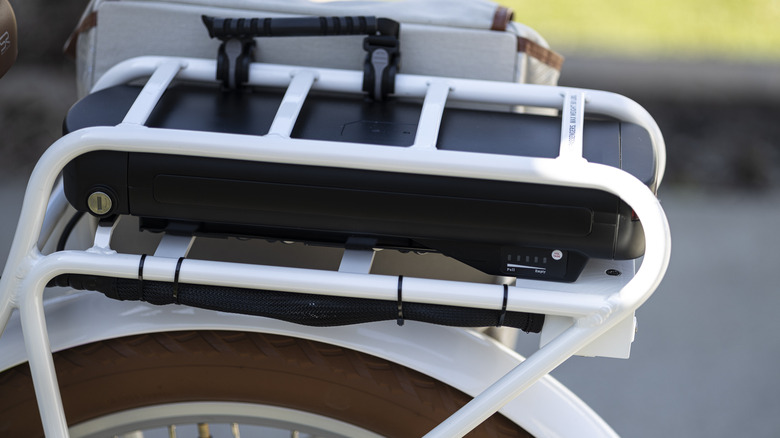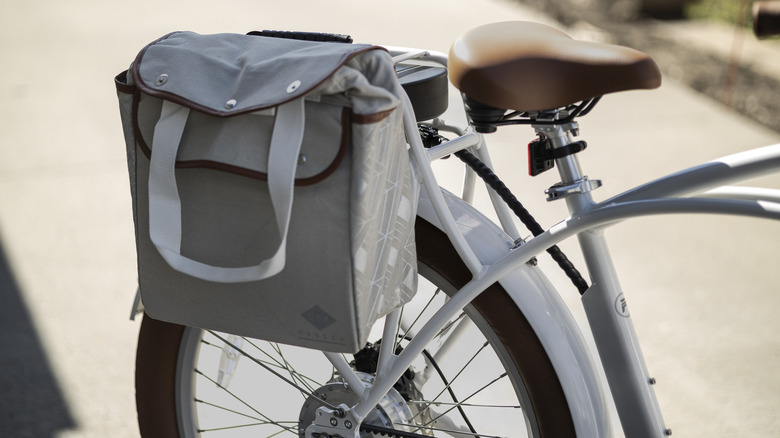Priority Bicycles E-Coast Review: An E-Bike Made For Smooth Summer Cruising
- Comfortable seat
- Smooth but powerful throttle
- Long battery life
- A bit jarring on bumps
- One of the pricier e-bike cruisers
Gulls squawking, the sound of waves, and a humid waterside wind whipping through your hair are arguably the best backdrops to hot summer days. To stitch it all together, though, you might want to consider an e-bike. Electric bikes use a small motor to propel the bike forward at low speeds and can be used in conjunction with or in replacement of pedaling. They may all look pretty similar, but e-bikes can be broken down into categories that serve different functions. Some electric bikes are tailored for hilly, intense cycling, some are ideal for the start-and-stop travel of city commuting, and others are best for gentle, low-stakes cruising.
The Priority e-Coast beach cruiser is certainly one of the most low-key e-bikes we've reviewed so far — made with wider tires, a rust-resistant frame, and a laid-back riding posture, it's a bike for when you've got somewhere to go but in no rush to get there. It's the new generation of Priority's Coast bicycle, a traditional mechanical bike meant for beach environments, and reportedly the only beach cruiser bike with an electric belt drive currently on the market. Priority Bicycles provided an e-Coast bike for the purpose of this review.
Ride and comfort
No one wants an uncomfortable e-bike. Because Priority had laid-back beach cycling in mind with the e-Coast, the majority of this bicycle's testing was done on paved bicycle paths and beaches that are mostly sandy. On smooth surfaces where there is little challenge or surprise in the terrain, the e-Coast performs exceptionally well — and that's exactly its intended purpose as a beach cruiser. The e-Coast glides like water across paths that are glassy smooth, like firmly-packed, even sand or flawlessly poured concrete. The aluminum body doesn't provide much forgiveness against bumps, cracks, and the like — even with the three-inch tires — so even on a pebble path relatively devoid of tumultuous terrain, all the small jolts and jars were felt in the handles and seat. Underneath the seat, there are a couple of small elastomer shock absorbers, but they aren't as capable as you might want them to be.
Outside of the absence of shock absorption, the bike is very comfortable, with a luxe, plush seat designed to prevent the dreaded bicyclist backend ache on long coastal jaunts. There are third-party bicycle seats with thicker cushioning out there, but the included seat on the e-Coast is the most comfortable built-in bicycle seat I've ever experienced. The e-Coast comes in two frame styles — diamond and step-through — to accommodate different preferences. I am 5 feet, 8 inches tall, and tested a diamond frame; if I were any shorter the step-through would be preferred. Priority says the recommended height range for the diamond is 5 feet, 5 inches through 6 feet, 5 inches, while the step-through's optimal range is 5 feet through 5 feet, 11 inches. Even if you fall within the height range for the diamond, if mobility for swinging a leg over the bike is a concern, go with the step-through.
Throttle, speed, and pedal assist
The e-Coast is powered by an electric belt single-speed drivetrain. The dual-control 500-watt rear wheel motor connects to a Gates Carbon Drive belt — which doesn't share the same issues of grease and rust as traditional bicycle chains. On the rear of the bike is a 576-watt-hour battery which, unlike in other cruiser models, is mounted above the back wheel.
With the e-Coast, you can expect a moderately sensitive twist throttle and gentle acceleration — ideal for flatter surfaces with minimal elevation range. As a Class 2 electric bike, the e-Coast arrives to the consumer with a maximum speed of 20 miles per hour but can be reprogrammed to the Class 3 limit of 28 miles per hour depending on local law.
You don't have to touch the twist throttle at all if you don't want to. The bike has five levels of pedal assistance; the cadence sensor will apply an appropriate amount of throttle based on your selected level of assistance and pedaling speed to maintain velocity. This sensor worked flawlessly in the testing and was generally my preferred application of the motor. Regardless of if you're using the pedal assist or the twist throttle, the bike is exceptionally quiet — the loudest function was braking. In fact, I checked with Priority to see if the loudness of the brakes was a concern, and their customer service was quick to offer solutions and assist via video.
Simple, easy to use controls
The e-Coast controls are simple and quick to catch on to; pedal assist levels are changed with the simple press of a button and can be done without taking your eyes off the road. The display screen reads out trip length, speed, and battery level. There are a couple of important features here for which the bike deserves high praise — namely the attention to safety with brake sensing technology. With this tech in play, the rear light on the bike brightens whenever you hold your bike brake.
The hydraulic disc brakes are smooth but capable even at the bike's highest speeds. The bike also has a motor stop function that kills the motor when you brake. I also really appreciated the e-Coast's integrated rack by the battery, which is great for attaching a couple of saddlebags to bring picnic supplies, a swimsuit, or other personal belongings.
The two-sided kickstand takes a bit to get accustomed to if you're only familiar with one-sided kickstands, but it does make propping the bike up easier and more secure after you're used to it. According to Priority, the e-Coast is unique from other beach cruisers in that its frame and hardware are specially designed to withstand rust and wear from salty beach air and ocean water. And lastly, the battery life is definitely worth mentioning; there are a lot of factors impacting battery range, including terrain elevation, level of pedal assistance, cyclist and saddle bag weight, and headwind, just to name a few. Priority says the average range of the e-Coast battery is 20 to 60 miles; by the time I had put in 25 miles of use on the bike, the battery indicator still read three-fifths of the battery life remaining.
The e-Coast vs. other electric cruisers
A key competitor to the cruiser we've reviewed here is the Blix Sol Eclipse. The Sol Eclipse is more affordable than the e-Coast at $1,899, has a gear-driven motor and battery, less height accommodation for riders, a shorter 45-mile average battery range, no rear light, and slimmer tires. And where the e-Coast takes care of storage for you with its integrated rack, the Sol Eclipse offers mounting points for modular racks. The Sol also comes with a bell, and the e-Coast doesn't. All in all, the Sol goes faster but for shorter differences, while also providing some more feature-based magnetism like customizable rack storage, a USB port to charge your phone, and a handlebar bell.
We could look at significantly more affordable options like the Retrospec Chatham Rev electric beach cruiser, which retails for just $899.99. The tires on this bike are slimmer than the e-Coast, but it provides the same slick rear mounting of the battery, similar rear rack storage, and one more pedal assist level than the e-Coast. However, potential range is a major handicap of the Chatham Rev — it can reach a max distance of 28 miles and has significantly less power in its 350W motor. The control panel isn't as high-tech, but there is a simpler thumb throttle and a Start Aid takeoff boost, which immediately pushes the bike forward at a speed of 4 miles per hour when you start peddling so there's no wobbling at low speeds. The Rev would be the preferred bike for beginners or people who only use their bicycle seasonally.
And don't forget the Swft Fleet while you're at it. In the Fleet, you have a cruiser-style e-bike for around $1000 for over 35 miles of range with a 500W motor.
The Priority e-Coast is the great summer cruiser
Overall, I can only speak very highly of the Priority e-Coast beach cruiser. It's an excellent bike that, while it may not naturally be the first choice for beginners or budget shoppers with its $1,999.99 listed retail price, works for its value mile after mile. I loved the comfortable, laid-back yet upright position the bike's stature organically encourages the rider. The saddle brown leather looks gorgeous against the stark white of the frame — the diamond model also comes in mint, indigo, and charcoal, which all look super elegant and clean, and Priority kindly includes a small bottle of touch-up paint to keep your bike pristine. The included saddle bag tote was roomy enough for my bag, camera, and a small amount of groceries. There's a lot to like.
While Priority doesn't offer its own modular storage system for the e-Coast, the brand suggests that the bike is compatible with lots of third-party storage systems be it bags, baskets, or even a surf rack. Priority's 174 Hudson Pannier tote bag ($69.99) was included with this review unit and it more than suited my needs.
The battery life is excellent assuming you're on minimally-sloping, flat terrain without gales of wind working against you, and the gentle throttle is perfect for a slow afternoon of cycling around the lake. However, the e-Coast is undersold if considered only a bike of leisure. Its stellar performance within its intended role is only exemplified by how much I enjoyed it for city travel and commuting. The comfortable seat and long battery life that was optimized for beach cruising also make this a great all-around e-bike at the beach and beyond.
